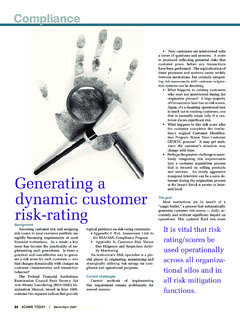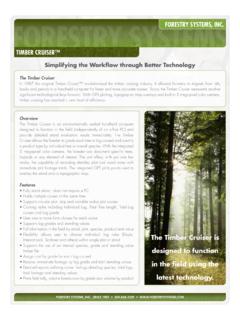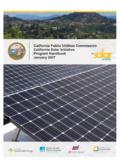Transcription of The Use of Global Assessments in Atopic Dermatitis ...
1 The Use of Global Assessments inNational Center for ChildHealth and DevelopmentThe Use of Global Assessments inAtopic Dermatitis research - ASystematic review of RandomizedControlled TrialsFutamura M, Thomas K, Nankervis H,Chalmers J, Williams HC, and Simpson ELOverview Introduction Results of systematic review Two examples Questions for groupIntroduction Global severity measures are often used indermatologic research Not based on numerical scoring They are intended to provide a clinicallymeaningful snapshot of disease severity easilyunderstandable to physicians and patients The type of scales used and implementationmethods vary between studies, howeverProblems with Global Assessments Not standardized in studies of atopicdermatitis Instructions have evolved over time Instructions have evolved over time While not a HOME core outcome, IGA used asthe reference point for validation studies Basis for FDA approval for new medications inADDermatology, 2004 Pediatrics, 2005Is the IGA an average of sign scoresor a measure of Global severity?
2 Or a measure of Global severity?Objectives To review the frequency of use,implementation, and analysis of globalseverity outcome measures in randomizedtrials in Atopic dermatitistrials in Atopic Dermatitis Long-term goal is to standardize andbetter-validate the measure for futurestudiesSearch Methods Searched all RCTs published since 2000 usingthe GREAT database GREAT database includes allpublishedRCTs GREAT database includes allpublishedRCTson Atopic Dermatitis (Nottingham) Included all RCTs with a Global severity scoreOutcomes Type of scale- dynamic or static Scale size (levels) Instructions for use Instructions for use Analytic methods301 RCTs on atopiceczemapublished since 2000283 RCTs18 conference abstracts97 RCTswithglobalseverityoutcome186 RCTswithoutglobalseverityoutcomeFigure 1. Flow diagramWho uses a Global Severity Measure?
3 AreaIGANo IGAT otalUSA,Canada41 (77%)12 (23%)53 CanadaEurope48 (30%)112 (70%)159 Other8 (11%)62 (89%)70 Total283 Global Severity Scale NamesIGA-Severity (9)IGA-Improvement (21)Investigator Global AssessmentInvestigator Global AD AssessmentInvestigator AssessmentInvestigator Global Severity ScoresInvestigator efficacy assessmentPhysicians Global AssessmentPhysicians Global EvaluationPhysicians Static Global AssessmentGlobal Severity ScoreInvestigator Global AssessmentInvestigator Global Assessment of improvementInvestigator Global Assessment of clinical responseInvestigator Global Assessment of Global responseInvestigator Assessment of the efficacyInvestigator-assessed Global changeInvestigator assessed overall efficacyInvestigator s overall AssessmentOverall assessment of efficacyAssessment of overall treatment responseAssessment of overall treatment responseGeneral improvement scoresGlobal AssessmentGlobal Assessment of effectivenessGlobal Assessment of treatment successGlobal
4 Dermatological assessmentGlobal EvaluationPhysicians Global AssessmentPhysicians Global Assessment of clinical responsePhysicians Assessment of Global responsePhysicians Global EvaluationPhysicians Global Evaluation of clinical responseAD Global Severity MeasureCharacteristics (n=97 RCTs) Dynamic scale in 38 RCTs (39%) Static scale in 60 RCTs (62%) Instructions for use in 26 trials (27%) Primary outcome in 29 trials (30%) Analysis of outcome varied- proportion oftreatment success, mean changeStatic Global Assessments (n=60)30405060 NumberofStudies010205 point6 point7 pointNumberofStudiesClear, Almost Clear, Mild, Moderate, Severe, Very SevereDefinition of Success (n=44)ScoreNumber (%)0-131 (70%)0-25 (11%)0-25 (11%)0-31 (2%)Other7 (16%)Conclusions Global Assessments are use commonly in AD trialsfrom North America, less so in other countries 30% of studies used IGA as primary outcome Size of scale varies Instructions regarding implementation rarelydescribed and vary Standardization neededCase 116 yo with Atopic dermatitisLesions cover 70% of bodyItching is severe, andtrouble sleepingWhat is the Global severity?
5 What is the Global severity?0-clear1-Almost clear2-Mild3-Moderate4-Severe5-Very SevereThe total body surface area is 70%.IGA ScoreClinical Description0 ClearNo inflammatory signs of AD1 Almost ClearJust percep. erythema andpapulation2 MildMild erythema and papulation3 ModerateModerate erythema andpapulationUsing standard instructions:4 SevereSevere erythema papulation5 Very SevereSevere erythema papulation withoozing/crustingCase 26 month baby with ADLesions on face onlySymptoms very mild, no effecton sleepWhat is the Global severity?0-clear1-Almost clear2-Mild3-Moderate4-Severe5-Very SevereUsing standard instructions,please determine the total body surface area is 2%.IGA ScoreClinical Description0 ClearNo inflammatory signs of AD1 Almost ClearJust percep. erythema andpapulation2 MildMild erythema and papulation3 ModerateModerate erythema andpapulation4 SevereSevere erythema papulation5 Very SevereSevere erythema papulationwith oozing/crustingQuestions What should the scale size for IGA be?
6 -Include almost clear and very severe? How should the instrument be implemented?-Use as a gestalt assessment? Should itch, QOL, etc-Use as a gestalt assessment? Should itch, QOL, etcbe factored in?-Current instructions based on sign scores only. Isthis OK? Should BSA be used to help determine this measure?-Studies in psoriasis show it already is (Ellis, 2004)Does Body Surface Area DetermineAD Severity? 50 children with AD (Manzoni, 2012)-BSA correlates with CDLQI (r=.428,P< ) 180 patients with AD aged 1-67 (Charman,2005)-BSA correlates with degree of bother(r= , P< )-Higher adjusted r2, than edema orerythema-Did not add anything to a model with signsOptions for Moving Forward Algorithmic approach ( Lattice PGA)Options for Moving Forward Algorithmic approach ( Lattice PGA) New numerical composite index incorporatingscoring system, itch, QOLscoring system, itch, QOL Keep as is, but provide some agreed-uponstandardized guidanceExample GuidanceSevere Disease In general, patients with severe disease have.
7 BSA of >10%EASI of >18 Deep or bright rederythema, very edematousDeep or bright rederythema, very edematouslesions with widespread, often deepexcoriationQuality of life is severely affectedVAS scores are often > 6cm (1-10 scale)AcknowledgementsHywelWilliamsJon HanifinNationalEczemaAssociationOREGON CLINICAL+ TRANSLATIONALRESEARCH INSTITUTET hank HOME initiative is partially supported through anindependent research programme funded by theNational Institute for Health research (NIHR) under itsProgramme Grants for Applied research fundingscheme (RP-PG-0407-10177).scheme (RP-PG-0407-10177).In particular, this grant has supported administration ofthe HOME project and patient representation at thisHOME III views expressed are those of the author(s) and notnecessarily those of the NHS, the NIHR or theDepartment of Health.










